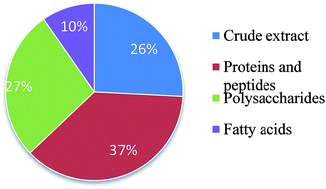Immunomodulatory properties of shellfish derivatives associated with human health
Abstract
Some vital components of marine shellfish are documented as an important source for both nutritional and pharmacological applications. These bioactive compounds are multifunctional in nature and they function as anti-inflammatory, antimicrobial, anticancer, antidiabetic and anti-hypertensive agents and so on. Shellfish-derived molecules such as lectins, glycoproteins, agglutinins and various endogenous free amino acids and fatty acids display potent immunomodulatory functions associated with human health. In addition, many synthetic immunomodulating agents are commercially available in the market, but they also cause some side effects to patients. However, immunomodulating substances derived from natural origins are safer and also cheaper in cost. Shellfish derivatives regulating biological activities and immune modulation are so far underexplored. Therefore, in this review, we discuss the immunomodulatory properties of shellfish-derived compounds to emphasize their therapeutic potential in human diseases.


 Please wait while we load your content...
Please wait while we load your content...